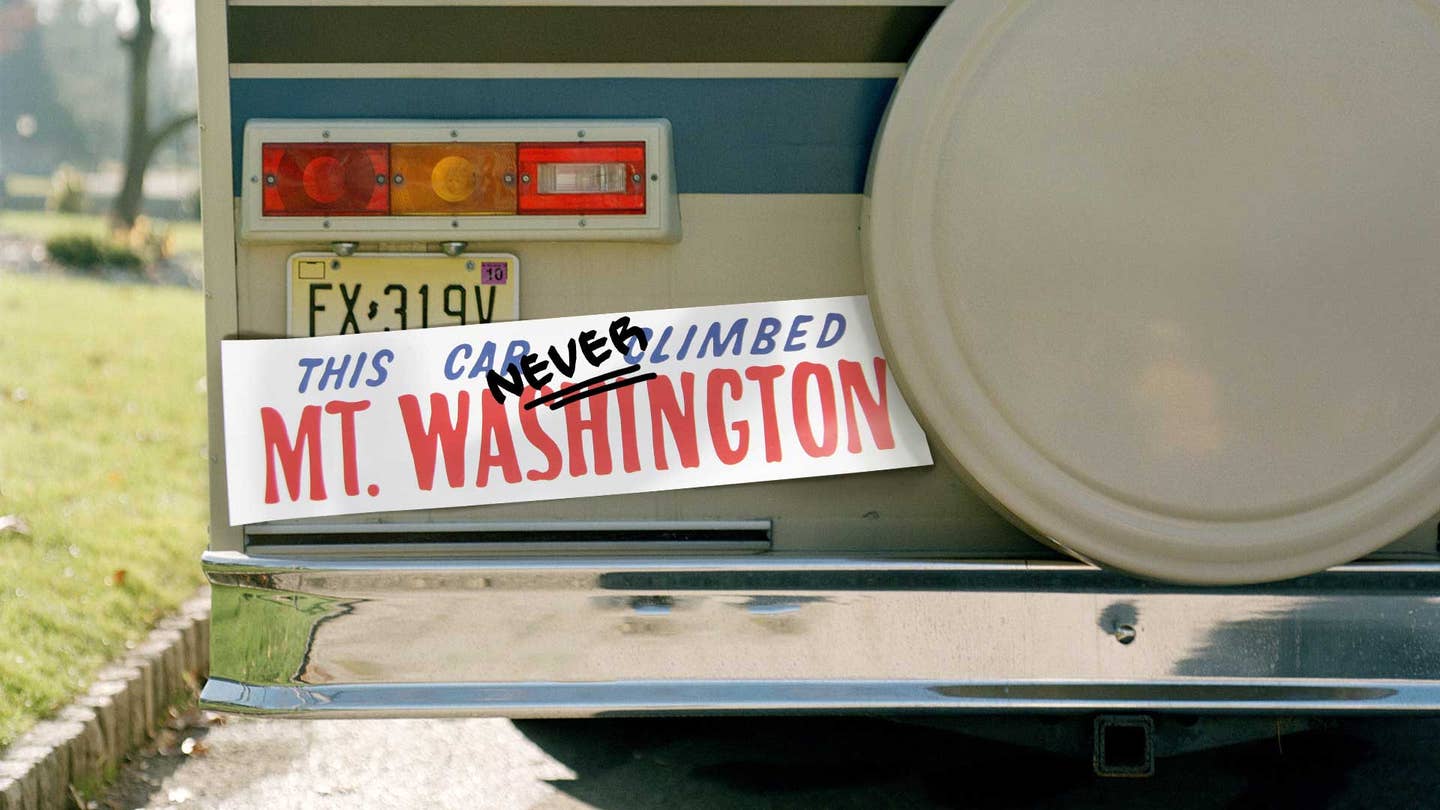The Story Behind Mt. Washington’s Bizarre List of Banned Cars
If you want the bumper sticker, be sure your car can make the climb.

What do the fourth-gen Lincoln Continental, Hummer H1 Alpha, old Jaguar XK8, and new Honda Ruckus have in common? Well, yes, smart-ass, internal-combustion engines and rubber tires. But they’re also now all banned from driving up Mount Washington. Wait. What?
New Hampshire’s tallest mountain is a harsh mistress. Its height of 6,288 feet may not sound like much compared to the stratospheric heights of the Seven Summits. But the area’s combination of geography and climate means driving up the Mount Washington Auto Road presents a particular set of problems for motor vehicles. So, over the years, the Auto Road’s management has come up with a lengthy, very specific list of cars that aren’t allowed up, and thus can never score one of those sweet “THIS CAR CLIMBED MT. WASHINGTON” bumper stickers.
“All of the [cars on the banned list] are based on actual experience,” Mt. Washington Auto Road general manager Howie Wemyss tells The Drive.
Most of the vehicles on the list are barred from entry not because of difficulties climbing the mountain, but rather, issues with coming back down. Take, for example, the following restriction: “No Lincoln Continentals, 1969 or earlier.” Seems awfully definitive, no? Well, according to Wemyss, the front brake line on earlier Continentals runs next to the front brake drum. Under heavy, continuous braking—like when descending a 7.6-mile-long hill at an average grade of 11.6 percent—the hot drums have a tendency to overheat the brake fluid, killing the front brakes.
One of the most frequent issues is an inability to hold the car in first gear—a problem that’s blacklisted everything from Jaguars to Saturns to Hondas and Acuras made prior to 2009. In the latter case, Wemyss said they spoke repeatedly with Honda about remedying the problem, which led to the Japanese automaker actually coming to the mountain to find a solution.
“They’ve been out here four or five times now” for brake and transmission testing, Wemyss said. “They actually gave us a statement once—they didn’t want to make a transmission that couldn’t handle Mount Washington.”
Honda’s scooters, however, are still not allowed to climb the mountain. In fact, the only scooter allowed to ride to the peak is the Suzuki Burgman—because its electronic braking system was demonstrated on the mountain for Auto Road personnel.
Hummer H1s, dually pickups and other large trucks, on the other hand, are banned due to size. If a vehicle spans more than 85 inches mirror-to-mirror, or has a wheelbase exceeding 161 inches, Auto Road toll collectors will tell the driver to turn around and go home. (There are marks on the pavement outlining the maximum dimensions, but toll takers have been known to break out the tape measure on occasion.)
“Partly it’s the size, and partly, it’s the perception of size,” Wemyss said. When drivers see something as big as a Hummer or a Silverado 2500HD coming at them on the narrow roadway, it tends to make them nervous, forcing them to the edge of a road that doesn’t have a lot of edge to begin with.
Like crossing the Brooklyn Bridge, excess weight can also pose a challenge for vehicles. The Auto Road used to decide whether or not a vehicle was overloaded by the number of occupants, but as waistlines have ballooned over the decades, toll booth attendants now are sometimes forced to ask passengers how much they weigh.
“It’s not a great position for our toll house people to be in, but it keeps everybody safe,” Wemyss said. “Frankly, the American public isn’t very small anymore.”
Still, the rules aren’t hard-and-fast. Wemyss said he’s been known to make the rare exception if he feels confident in a driver’s ability to handle the car on the road. But the toll takers tend towards the “better safe than sorry” doctrine.
“We have to dumb everything down to the lowest common denominator,” he said.
